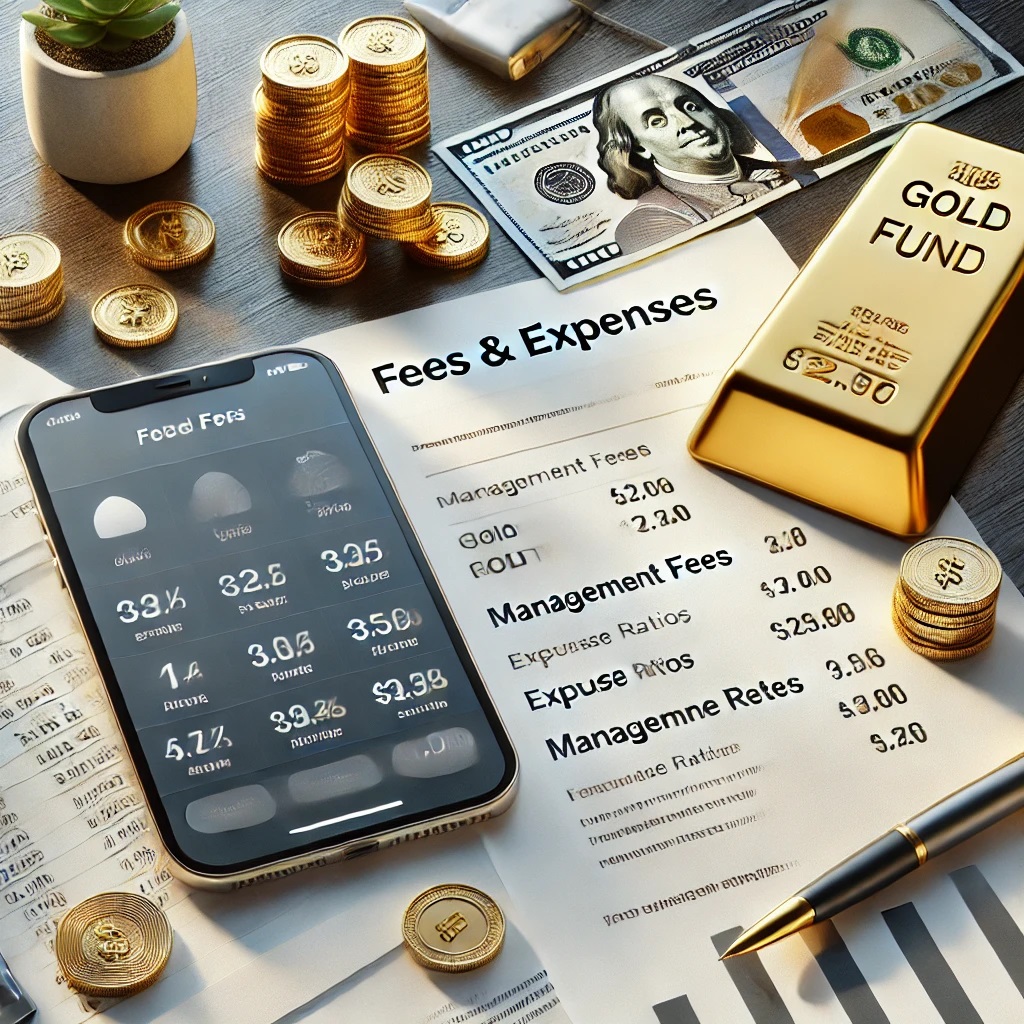What are Gold Funds?
28/11/2024Daniel Fisher
Free & fully insured UK Delivery. Learn more
Secure & flexible payments. Learn more

Buyback Guarantee Learn more

Gold has long been a symbol of wealth and a trusted investment choice, especially during times of economic uncertainty. Its enduring value makes it a popular addition to investment portfolios to help provide balance and security. Today, there are many ways to invest in gold, from purchasing physical gold to exploring more modern options like gold funds.
Gold funds, in particular, have gained traction as a convenient and accessible way to invest in gold without the hassle of owning and storing it. Whether you’re a seasoned investor or just starting out, understanding what gold funds are and how they work can help you decide if they’re the right fit for your financial goals.
In this post, we’ll break down everything you need to know about the various gold funds, how they differ from other gold investments, and why they could be a smart choice for diversifying your portfolio.
Gold funds are a modern investment vehicle that provides an easy and hassle-free way to invest in gold. They eliminate the need for physical storage and offer a convenient option for individuals looking to include gold in their portfolio without directly purchasing it.
Gold funds are investment funds or exchange-traded funds (ETFs) that focus on gold or gold-related assets. Instead of buying physical gold like coins or bars, investors can put their money into these funds, which track the performance of gold prices or companies associated with the gold industry.
These funds are managed by specialist fund managers who allocate investments strategically, ensuring that they align with the underlying goal—offering returns that mirror the movement of gold prices. Essentially, gold funds make it easy for anyone to invest in gold without worrying about its physical handling or security.
Gold funds come in different forms, each tailored to meet various investor needs and preferences. The nuances of each provide very different market and risk exposure, and variance in performance.
1.Physical Gold-Based Funds
These funds invest in actual gold bullion reserves or securities backed by physical gold. The fund’s value closely tracks the price of gold in the market, offering investors a direct way to benefit from gold price fluctuations. This option suits investors wishing to have electronic exposure to real gold prices.
2. Gold Mining Funds
These funds focus on companies involved in the extraction, processing, and production of gold. Their performance is influenced by both gold prices and the operational success of the mining companies. While they can offer higher returns, they also carry additional risks related to the mining industry.
This option is attractive to investors seeking exposure to gold mines but who wish to spread their risk amongst a pool of different gold mining operations. The fund manager may select mining companies across various mining methods, locations, and development stage.
3. Gold ETFs (Exchange-Traded Funds)
Gold ETFs are a popular choice for investors who want the flexibility of stock market trading combined with exposure to the gold price. Each unit of a gold ETF typically represents a certain amount of gold, making it easy to buy, sell, or trade just like any other stock.
Each type of gold fund has its own set of benefits and risks, allowing investors to choose based on their goals, risk tolerance, and investment strategy.
Free ultimate guide for keen precious metals investor
Making money from owning physical gold coins and bars is a straightforward concept. Buy the piece of gold at one price, wait for gold to appreciate in value, then sell it at the higher price. But how do the mechanics of gold funds work?
By pooling money from multiple investors, these funds are managed by professionals who strategically allocate assets to provide returns closely linked to the price of gold or gold-related investments. Here’s a closer look at how they operate.
Gold funds are structured as open-ended investment companies (OEICs) or exchange-traded funds (ETFs), with the goal of mirroring the performance of gold. Fund managers typically invest in one or more of the following:
This structure allows investors to benefit from the movements in gold prices without direct involvement in managing physical gold. The fund’s assets are held in a diversified portfolio to reduce risks while maximizing potential returns.
Gold funds’ performance is heavily influenced by the price of gold in the global market. When gold prices rise, the value of the fund typically increases, and when prices fall, the fund’s value may decline.
This price-tracking feature makes gold funds a reliable way to gain exposure to gold’s market movements.

One of the key advantages of gold funds is their liquidity and ease of transaction:
Whether you prefer the flexibility of daily trading or a longer-term investment approach, gold funds cater to a range of investment styles and objectives.
Gold funds offer a range of advantages that make them an appealing option for investors. From convenience to affordability, these benefits allow investors to access gold markets without the challenges of traditional gold ownership.
Investing in gold funds eliminates the need to store physical gold securely. Unlike gold bars or coins, which require safes or bank lockers, gold funds exist in electronic form. Of course, most physical gold dealers will offer professional vaulting services, but this represents an additional cost to investors. Gold funds offer:
With gold funds, investors gain exposure to gold’s value without the worry and cost of handling physical assets.

Gold funds are highly liquid and easier to trade compared to physical gold.
This ease of buying and selling ensures that investors can access their funds whenever needed, without delays.
Gold funds serve as an effective tool for diversifying investment portfolios.
By including gold funds in a portfolio, investors can reduce overall risk, iron out volatility, and add balance.

Unlike physical gold, which may require a significant upfront purchase, gold funds are more affordable. As gold prices continue to increase, the minimum investment amount of physical gold also grows, as the price of the smallest available bar or coin rises. But units in a gold fund provide accessibility comparable to buying a fractional amount of a gold bar.
Gold funds are typically offered by asset management companies that also provide access to other investment options, such as stocks, bonds, and mutual funds.
Many gold funds provide access to online portals where investors can monitor the value of their holdings 24/7.
This accessibility ensures that investors stay informed about their investments at all times.

Some mutual funds invest in gold derivatives, such as gold futures and options, providing exposure to more sophisticated financial instruments.
This advanced investment option can be particularly appealing for those with higher risk tolerance or a more active investment strategy. Gold derivative funds reduce the burden of expertise required when trading directly into such complex instruments.
While gold funds offer numerous advantages, they also come with certain risks and considerations that investors should be aware of before committing their money. These can relate to gold as an asset class, or more specifically to the fund structure and exposure. Understanding these factors will help you make informed decisions aligned with your financial goals.

The value of gold funds is heavily influenced by fluctuations in gold prices, which can be volatile.
Investors should be prepared for periods of instability and consider their risk tolerance before investing. While gold prices have risen throughout history, it’s important to remember that just like with stocks, gold prices can fall in value. The wisest strategy is usually to spread risk between gold and other well-researched asset classes.
Gold funds are managed by professional institutions, which introduces risks related to the performance and stability of these entities.
Investors should assess the reputation and track record of the fund management company and consider the inherent risks in mining-related investments.

Investing in gold funds isn’t free and often comes with associated costs:
It’s essential to review a fund’s fee structure and compare it with its potential returns to ensure it aligns with your investment objectives. Not all funds charge the same, so shop around and weigh up costs versus performance.
Gold funds can suit different investment timelines, but each approach has unique challenges:
Choosing the right investment horizon depends on your financial goals, risk appetite, and market outlook.
Getting started with gold funds in the UK is a straightforward process, but it’s important to approach it with a clear plan. From selecting the right fund to choosing the best investment platform, base your choices on those which meet your personal investment objectives.
Selecting the right gold fund is a crucial step, as it impacts your returns and aligns your investment with your financial goals. Here are key factors to consider:
In the UK, a wide range of platforms allows investors to buy and manage gold funds easily. Selecting the right platform depends on your preferences and investment style.
Check out the latest prices
Deciding between gold funds and physical gold depends on your investment goals, risk tolerance, and practical considerations. Both options provide exposure to the value of gold, but they differ significantly in terms of storage, liquidity, taxes, potential returns, risk, and costs. While some investors simply want the comfort of owning real tangible physical gold, others spread allocation between various gold investment methods.
Who Might Prefer This?
Investors who value convenience and simplicity may prefer gold funds, while those who want tangible assets they can physically own, know you can’t beat having physical gold in hand.
Who Might Prefer This?
Gold funds suit investors looking for quick and easy transactions. Physical gold can also be converted in cash quickly but with the added layer of having to physically transfer the gold to the buyer.
Who Might Prefer This?
UK investors looking for tax-efficient options may lean towards physical gold coins, while those unconcerned with taxes may find gold funds more convenient. For those focussed on having gold exposure within their pension, gold funds may provide flexibility to add these into a wider range of pension types, while gold bullion can only be held within a SIPP.
Inheritance tax is payable on both physical and electronic gold assets, but the private nature of physical gold transactions appeals to those with inheritance tax concerns.

Who Might Prefer This?
Investors seeking predictable exposure to gold’s market price may prefer gold ETFs, while those interested in potentially higher returns from rarer coins might opt for physical gold.
Who Might Prefer This?
Investors wary of counterparty risk will always favour physical gold, while those comfortable with professionally managed investments may prefer funds.
Who Might Prefer This?
Short term investors and those wishing to actively trade the gold market will almost certainly benefit from the smaller spreads involved in electronic ownership. Longer term “buy and hold” investors realise that larger spreads for owning the real thing can be overcome easily over time.


Gold funds are generally safe investments, offering exposure to gold without owning physical metal. They are backed by gold or track gold prices, providing stability during economic uncertainty. However, they carry risks like market fluctuations and fund mismanagement.
Gold funds such as ETFs track the price of gold. As such, capital invested can fall in value if the gold price falls. Investors should also factor in the ongoing cost of fund management fees. Funds tied to gold mining stocks are deemed riskier as they have exposure to individual company performance.
The best gold fund depends on your goals. SPDR Gold Shares (GLD) is a popular option, backed by physical gold and offering low expenses. For diversification, consider iShares Gold Trust (IAU) or funds investing in gold mining stocks for higher risk and potential returns. Always review fees, performance, and investment objectives before choosing.
A gold fund focuses on gold or related assets, like bullion or mining stocks, offering exposure to gold prices. A mutual fund is a US term, like the UK OEIC, which invests across diverse assets, such as stocks or bonds, for broader diversification. Gold funds are less volatile but depend on gold prices, while mutual funds vary in risk based on their asset mix and market performance.
Live Gold Spot Price in Sterling. Gold is one of the densest of all metals. It is a good conductor of heat and electricity. It is also soft and the most malleable and ductile of the elements; an ounce (31.1 grams; gold is weighed in troy ounces) can be beaten out to 187 square feet (about 17 square metres) in extremely thin sheets called gold leaf.
Live Silver Spot Price in Sterling. Silver (Ag), chemical element, a white lustrous metal valued for its decorative beauty and electrical conductivity. Silver is located in Group 11 (Ib) and Period 5 of the periodic table, between copper (Period 4) and gold (Period 6), and its physical and chemical properties are intermediate between those two metals.